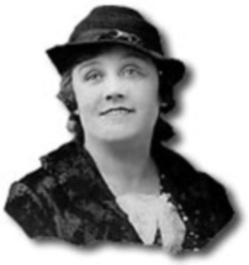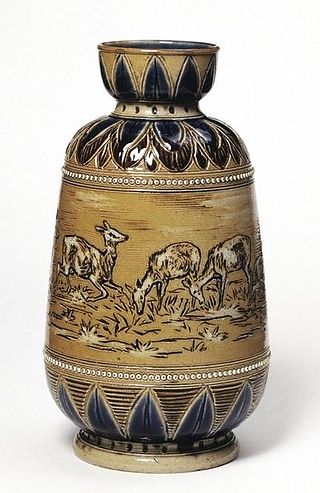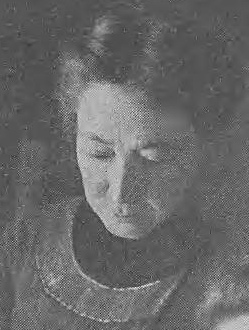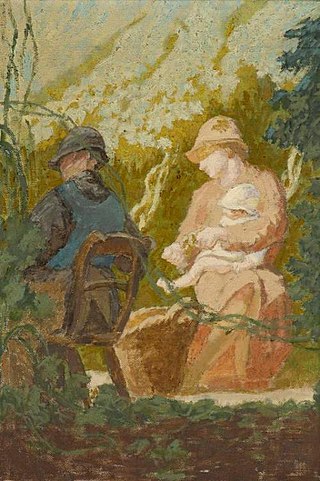Related Research Articles

Clarice Cliff was an English ceramic artist and designer. Active from 1922 to 1963, Cliff became the head of the Newport Pottery factory creative department.

Susan Vera Cooper OBE was a prolific English ceramic designer working in the Stoke-on-Trent pottery industries from the 1920s to the 1980s.

Eva Striker Zeisel was a Hungarian-born American industrial designer known for her work with ceramics, primarily from the period after she immigrated to the United States. Her forms are often abstractions of the natural world and human relationships. Work from throughout her prodigious career is included in important museum collections across the world. Zeisel declared herself a "maker of useful things."

Wedgwood is an English fine china, porcelain and luxury accessories manufacturer that was founded on 1 May 1759 by the potter and entrepreneur Josiah Wedgwood and was first incorporated in 1895 as Josiah Wedgwood and Sons Ltd. It was rapidly successful and was soon one of the largest manufacturers of Staffordshire pottery, "a firm that has done more to spread the knowledge and enhance the reputation of British ceramic art than any other manufacturer", exporting across Europe as far as Russia, and to the Americas. It was especially successful at producing fine earthenware and stoneware that were accepted as equivalent in quality to porcelain, though considerably less expensive.

Royal Doulton is an English ceramic and home accessories manufacturer that was founded in 1815. Operating originally in Vauxhall, London, and later moving to Lambeth, in 1882 it opened a factory in Burslem, Stoke-on-Trent, in the centre of English pottery. From the start, the backbone of the business was a wide range of utilitarian wares, mostly stonewares, including storage jars, tankards and the like, and later extending to drain pipes, lavatories, water filters, electrical porcelain and other technical ceramics. From 1853 to 1901, its wares were marked Doulton & Co., then from 1901, when a royal warrant was given, Royal Doulton.
W. Moorcroft Limited is a British art pottery manufacturer specialising in richly decorated earthenware. based at Burslem in Stoke-on-Trent, England. The company was founded by William Moorcroft in 1913.

Mintons was a major company in Staffordshire pottery, "Europe's leading ceramic factory during the Victorian era", an independent business from 1793 to 1968. It was a leader in ceramic design, working in a number of different ceramic bodies, decorative techniques, and "a glorious pot-pourri of styles - Rococo shapes with Oriental motifs, Classical shapes with Medieval designs and Art Nouveau borders were among the many wonderful concoctions". As well as pottery vessels and sculptures, the firm was a leading manufacturer of tiles and other architectural ceramics, producing work for both the Houses of Parliament and United States Capitol.

Blue pottery is widely recognized as a traditional craft of Jaipur of Central Asian origin. The name 'blue pottery' comes from the eye-catching cobalt blue dye used to colour the pottery. It is one of many Eurasian types of blue and white pottery, and related in the shapes and decoration to Islamic pottery and, more distantly, Chinese pottery.
The Overbeck sisters were American women potters and artists of the Arts and Crafts Movement who established Overbeck Pottery in their Cambridge City, Indiana, home in 1911 with the goal of producing original, high-quality, hand-wrought ceramics as their primary source of income. The sisters are best known for their fanciful figurines, their skill in matte glazes, and their stylized designs of plants and animals in the Art Nouveau and Art Deco styles. The women owned and handled all aspects of their artistic enterprise until 1955, when the last of the sisters died and the pottery closed. As a result of their efforts, the Overbecks managed to become economically independent and earned a modest living from the sales of their art.
Dorothy Jessie Tait was a prolific English ceramic designer working in the Stoke-on-Trent pottery industries, most prominently for Midwinter, from the 1940s to the 1980s.

Adelaide Alsop Robineau (1865–1929) was an American china painter and potter, and is considered one of the top ceramists of American art pottery in her era.

Art pottery is a term for pottery with artistic aspirations, made in relatively small quantities, mostly between about 1870 and 1930. Typically, sets of the usual tableware items are excluded from the term; instead the objects produced are mostly decorative vessels such as vases, jugs, bowls and the like which are sold singly. The term originated in the later 19th century, and is usually used only for pottery produced from that period onwards. It tends to be used for ceramics produced in factory conditions, but in relatively small quantities, using skilled workers, with at the least close supervision by a designer or some sort of artistic director. Studio pottery is a step up, supposed to be produced in even smaller quantities, with the hands-on participation of an artist-potter, who often performs all or most of the production stages. But the use of both terms can be elastic. Ceramic art is often a much wider term, covering all pottery that comes within the scope of art history, but "ceramic artist" is often used for hands-on artist potters in studio pottery.

Henrietta Barclay Paist (1870–1930) was an American artist, designer, teacher, and author. She is perhaps best known for her china painting, a popular turn-of-the-century pastime. Born in Red Wing, Minnesota in 1870, she studied ceramics in Germany, watercolor painting in Minneapolis, and design in Chicago before settling in the Twin Cities, where she also found time to marry and raise a family.
Sally Tuffin is an English fashion designer and ceramicist who, with Marion Foale, was half of Foale and Tuffin, the groundbreaking fashion label that was part of the "youthquake" movement in 1960s London.

Herman August Kähler, usually known as Herman A. Kähler, was a Danish ceramic designer and manufacturer who ran the Kähler ceramic factory in Næstved, Denmark. His daughter Sigrid married the painter L.A. Ring.

China painting, or porcelain painting, is the decoration of glazed porcelain objects such as plates, bowls, vases or statues. The body of the object may be hard-paste porcelain, developed in China in the 7th or 8th century, or soft-paste porcelain, developed in 18th-century Europe. The broader term ceramic painting includes painted decoration on lead-glazed earthenware such as creamware or tin-glazed pottery such as maiolica or faience.
Ada Louise Powell, née Lessore, was a British designer. Her illustrious family included her grandfather Émile Lessore, a free hand designer for Wedgwood, and her sister Thérèse Lessore. Her father, Jules Lessore, also decorated pottery but was primarily a marine painter, he had exhibitions at the Royal Academy and Paris Salon. Powell studied calligraphy at the Central School of Arts and Crafts. "She became highly skilled and well known, illuminating some of William Morris’ incomplete work, and extending her interests to decorative designs and the painting of furniture for Ernest Grimson". Ada thus had historical family connections to the arts and to Wedgwood, however after her father died in 1892 her progression in the arts was perhaps more indebted to the encouragement and aligned interests of her mother and siblings. Her sister, Thérèse Lessore, was a painter and founder member of the London Group and who decorated Wedgwood blanks in the 1920s and her brother Frederick was a portrait sculptor who opened the Beaux Arts Gallery. Ada Louise married Alfred Hoare Powell on Thursday, 6 September 1906 and, in their ceramic works, they developed an artistic partnership.

Thérèse Lessore was a British artist who worked in oil and watercolour. She was a founder member of the London Group, and the third wife of Walter Sickert.

Millicent (Millie) Jane Taplin (1902–1980) was a British designer and painter of ceramics who spent most of her career at Josiah Wedgwood and Sons (1917–1962). She was trained in painting by Alfred and Louise Powell, and supervised Wedgwood's ceramics painters. She became a designer of decorative patterns in 1929 and by the mid-to-late 1930s was one of the company's main designers, although she did not design pottery shapes. She was one of only two working-class women to become a successful ceramics designer before the Second World War. Her tableware designs were exhibited by Wedgwood at Grafton Galleries in London in 1936, and several of her designs are now on display at the V&A Museum. Her design "Strawberry Hill", with Victor Skellern, was awarded the Council of Industrial Design's Design of the Year Award in 1957.

Beata Mårtensson-Brummer was a Swedish painter, ceramist, art teacher and philanthropist. After studying in Stockholm, France and Italy, from 1908 she worked at the Gustavsberg Porcelain Factory where she designed glazed vases and pottery. She taught painting at the Högre konstindustriella skolan where she was appointed head teacher in 1915. In 1911, she married the Hungarian-born sculptor Joseph Brummer. After first helping him to run his gallery in Paris, in 1920 she joined him in New York where he ran the Brummer Gallery in Manhattan until his death in 1947. Mårtensson-Brummer returned to Sweden in 1953. On her death in 1956, she bequeathed considerable amounts of funding to Sweden's cultural institutions.
References
- 1 2 "Emma Bossons". LindaClifford.com. Archived from the original on 18 November 2008. Retrieved 5 December 2007.
- ↑ Walker, Melanie (9 March 2023). "Potter is 'honoured' to be Throw Down judge". Congleton Chronicle . p. 14.
- 1 2 "Firm insures designer for £1.5m". BBC.co.uk. 11 September 2005. Retrieved 5 December 2007.
- ↑ "Emma Bossons". abitofbritain.com. Retrieved 7 January 2008.
- ↑ Wainwright, Martin (12 September 2005). "Ceramics firm insures star designer for £1.5m". The Guardian. London. Retrieved 7 January 2008.
- ↑ "Designer praised for pottery success". BBC.co.uk. 6 December 2002. Retrieved 7 January 2008.
- ↑ "Queen's Choice Vase". W Moorcroft Ltd. 25 April 2018. Archived from the original on 25 April 2018. Retrieved 25 April 2018.